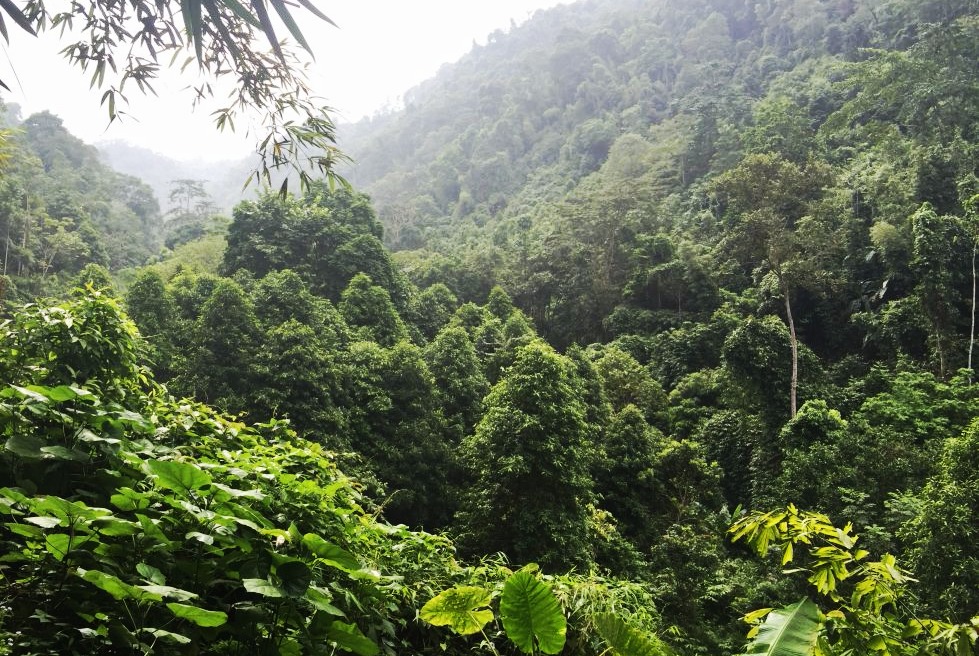A light scent of herbs lingered in the humid forest air. A dozen ears listened to the local guide and his stories about the plants around them. He could spend hours talking about the multiple species, their positive interactions with the natural environment and the ways to prepare them for medical purposes. The Ardisia silvestris (lá khôi tía) could help for example against stomachache, while Polyscias fruticosa (dinh lang) could support digestion.
The local guide is Mr. Thuy’s father. His son Mr. Trieu Van Thuy (called “Thuy”) is the Village Party Secretary of the village Khuoi Lung, located in the My Phuong commune, Bac Kan Province. The Village Party Secretary is leader of the Communist Party of Vietnam organization in Khuoi Lung.
On 6 September 2016, Mr. Thuy led a delegation of the UN-REDD Programme to the protected forest area. The delegation had travelled to the area for a special event during which the authorities in Bac Kan officially launched the Provincial REDD+ Action Plan (PRAP). With support from the UN-REDD Viet Nam Phase II Programme and the Forest Inventory and Planning Institute (FIPI), provincial authorities and various stakeholders concluded an intensive process of analysis and consultations to improve synergies between forests, climate change, livelihoods and development in the province.
Mr. Thuy used the launch event to explain the way farmers who protect the natural forest take advantage of livelihood opportunities, building on local knowledge and additional support brought by REDD+. Thuy’s father and two other elderly men in the village know how to use forest trees and plants as medicine. The Programme gave them the opportunity to share their knowledge and mobilize villagers to plant more medicinal plants under natural forests canopies as well as plantations and in agroforestry gardens.
In Viet Nam, most people use traditional medicine for healing, and 90% of active ingredients come from forests. Ethnic minorities are particularly involved in collecting and processing forest plants for medical purposes. They are among the poorest and most vulnerable communities, but they hold a rich tradition and thorough knowledge of medicinal plants.
In the commune of My Phuong, the UN-REDD Programme supports scaling up activities so that this ethnic minority can increase and sustain its benefits from surrounding natural forests. Khuoi Lung is one of the targeted areas for piloting community-based forest management and upscaling the collection, processing and trade of traditional herbs grown under the forest canopy. The village has 26 households, including eight considered poor.
This initiative has the potential to transform the way natural forests are perceived and protected in Viet Nam. Mr. Fabien Monteils, Chief Technical Advisor of the UN-REDD Programme, explains:
“The evolution of Viet Nam’s forest cover, with expansion of plantations and loss of natural forests, is characteristic of a fundamental challenge: Local people see the direct benefits from plantations, they make money out of it.
But they don’t see tangible ways to benefit sustainably from natural forests. Natural forests are still often and wrongly seen as a burden to development rather than a factor of resilience and opportunity. With this project, Thuy and My Phuong villagers demonstrate that people can earn good income and improve their livelihoods by investing in healthy natural forests rather than depleting them.”
Forest protection: Bac Kan shows chances and challenges
Bac Kan Province offers a good illustration of the opportunities and challenges for reducing emissions from deforestation and forest degradation while restoring forests in Viet Nam. Statistically, forest cover of this northern province increased from 65% in 2005 to 71% in 2014, with a 3% contraction of natural forests (-14,000 ha).
Plantations were multiplied by four, from 16,000 ha to 59,000 ha. However, only within a five-year period, from 2010 to 2014, rich natural forests have been reduced at the alarming rate of 37%[1]. Illegal logging, agriculture expansion, fire, and a combination of these factors account for the major drivers of deforestation.
Finding and realizing solutions for addressing those drivers is not an easy task. As in many parts of Viet Nam and in the tropical world, the fundamental issue is the economy and governance: natural forests provide invaluable benefits for human societies, but these benefits are not adequately captured by markets and tangible economic (or financial) opportunities for individuals and households.
Medicinal plants show good potential of development, as the market for medicinal products with ingredients like dinh lang is booming nationally and internationally from neighboring China and beyond.
Now that the PRAP has been launched, this plan shall be implemented. The UN-REDD Programme supports some aspects of the PRAP, for instance support for forest land allocation and sustainable forest management through alternate livelihoods like in My Phuong. The experience in Bac Kan will also inspire other provinces in Vietnam to move ahead with REDD+ planning and implementation, and inform the revision of the National REDD+ Action Programme to be finalized in December 2016.
The UN-REDD Programme believes that My Phuong’s experience can transform the relationship between people and natural forests and end the over-exploitation of plants to produce medicine, shifting to a sustainable management of plants.
Authors: This article was written by the UN-REDD Programme's Viet Nam country team.
[1] Source: Bac Kan Provincial REDD+ Action Plan (PRAP) (2016)
